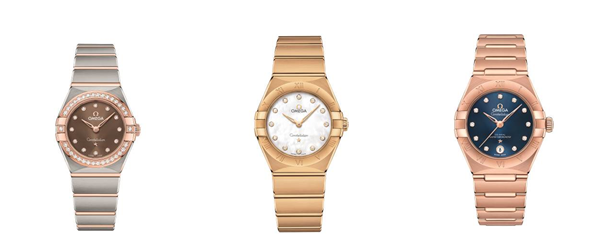The Constellation collection has long been OMEGA’s symbol of unrivalled precision in watchmaking.
With a name inspired by the stars above us, it has sought to redefine the standards by which we measure time and has always done so with elegant beauty and class.
This year, the Constellation takes its next step in design and technology, offering 101 new models for women which not only offer exceptional variety, but also the excellence of precision that this family of watches is known for. In the 29 mm models, mechanical supremacy is delivered through the inclusion of an OMEGA Master Co-Axial movement, assured by the 8 strict tests that every Master Chronometer certified watch faces before it leaves the factory.
Yet for this entire new line, it is the outward craftsmanship that truly stands out. The refined makeover has touched upon almost every part of the iconic design, while still keeping the central “Manhattan” look that has been a firm favourite for more than 36 years.
The moment of discovery has arrived.
With a name inspired by the stars above us, it has sought to redefine the standards by which we measure time and has always done so with elegant beauty and class.
This year, the Constellation takes its next step in design and technology, offering 101 new models for women which not only offer exceptional variety, but also the excellence of precision that this family of watches is known for. In the 29 mm models, mechanical supremacy is delivered through the inclusion of an OMEGA Master Co-Axial movement, assured by the 8 strict tests that every Master Chronometer certified watch faces before it leaves the factory.
Yet for this entire new line, it is the outward craftsmanship that truly stands out. The refined makeover has touched upon almost every part of the iconic design, while still keeping the central “Manhattan” look that has been a firm favourite for more than 36 years.
The moment of discovery has arrived.
When the Constellation was born
The OMEGA Constellation was introduced to the world in 1952, yet its origins began some four years earlier. To celebrate the brand’s 100-year anniversary in 1948, OMEGA released its first chronometer-certified wristwatch with an automatic movement. This model, named the “Centenary”, was greeted with such delight by connoisseurs of precision, that OMEGA recognised the need for a fully-established collection with the same official status.
Four years later, the Constellation arrived. This moment marked the first time that any brand had created a family of watches that consisted only of chronometers. The certified excellence was a huge signal of intent and undeniably proved the brand’s dedication to accuracy.
Of course, the look was quite different to the one we see presented in 2018. But even today, our new models remain true to some of those early characteristics, such as the elegant design, uncluttered round dial and the application of a diminutive gold star.
The OMEGA Constellation was introduced to the world in 1952, yet its origins began some four years earlier. To celebrate the brand’s 100-year anniversary in 1948, OMEGA released its first chronometer-certified wristwatch with an automatic movement. This model, named the “Centenary”, was greeted with such delight by connoisseurs of precision, that OMEGA recognised the need for a fully-established collection with the same official status.
Four years later, the Constellation arrived. This moment marked the first time that any brand had created a family of watches that consisted only of chronometers. The certified excellence was a huge signal of intent and undeniably proved the brand’s dedication to accuracy.
Of course, the look was quite different to the one we see presented in 2018. But even today, our new models remain true to some of those early characteristics, such as the elegant design, uncluttered round dial and the application of a diminutive gold star.
Observatory Under The Stars
Since 1952, the Constellation collection has been symbolised by the inspiring “observatory under the stars” medallion on the casebacks of many models. Its meaning has deep significance within OMEGA and also has a modern interpretation that is truly relevant to the brand today.
The story begins in 1933, when OMEGA achieved a world record for precision at the observatory of Kew-Teddington in England. The company then repeated this achievement in 1936, when it returned to the same observatory and set yet another world record for precision in all categories, an accomplishment that still remains unbeaten.
That may be impressive enough, but in 1945, the Geneva Observatory introduced the “wristwatch-sized” movement category to its annual precision contests, and in the eight years that followed, OMEGA won an incredible six times.
By 1952, when a symbol of precision was required for the new Constellation collection, the OMEGA designers found inspiration from that successful past. Their medallion was created with an observatory cupola reminiscent of the Geneva Observatory, while the eight stars represented those two world records of 1933 and 1936, and the six contests won between 1945 and 1952.
Today, the eight stars have also come to represent OMEGA’s modern achievements in precision, notably the eight tests that each mechanical OMEGA watch must pass in order to become a Master Chronometer. Set by the Swiss Federal Institute of Metrology (METAS), the tests are the most stringent within the industry, proving a standard of precision, performance and magnetic-resistance that is quite unlike any other.
Since 1952, the Constellation collection has been symbolised by the inspiring “observatory under the stars” medallion on the casebacks of many models. Its meaning has deep significance within OMEGA and also has a modern interpretation that is truly relevant to the brand today.
The story begins in 1933, when OMEGA achieved a world record for precision at the observatory of Kew-Teddington in England. The company then repeated this achievement in 1936, when it returned to the same observatory and set yet another world record for precision in all categories, an accomplishment that still remains unbeaten.
That may be impressive enough, but in 1945, the Geneva Observatory introduced the “wristwatch-sized” movement category to its annual precision contests, and in the eight years that followed, OMEGA won an incredible six times.
By 1952, when a symbol of precision was required for the new Constellation collection, the OMEGA designers found inspiration from that successful past. Their medallion was created with an observatory cupola reminiscent of the Geneva Observatory, while the eight stars represented those two world records of 1933 and 1936, and the six contests won between 1945 and 1952.
Today, the eight stars have also come to represent OMEGA’s modern achievements in precision, notably the eight tests that each mechanical OMEGA watch must pass in order to become a Master Chronometer. Set by the Swiss Federal Institute of Metrology (METAS), the tests are the most stringent within the industry, proving a standard of precision, performance and magnetic-resistance that is quite unlike any other.
The Manhattan signals the modern look
1982 – Constellation “Manhattan”
The elegant “Manhattan” design is one that we most associate with the Constellation today. Most notably, it introduced the four iconic claws. At the time, these held the sapphire crystal and gasket against the case, assuring the watch’s water-resistance. As well as this, we can see the barrel-shaped case with its famous half-moon facets, the perfectly circular dial, and indexes on the bezel. Finally, there’s the familiar integrated bracelet with hinged links that added sophistication and comfort.
1995 – Constellation ‘95
For the first serious update, OMEGA kept the claws as a design feature, but they were no longer needed for water-resistance. Each model was also given softened and rounded lines, domed sapphire crystal, Roman numerals on the bezel instead of the dial, and elegant “baton” indexes and diamonds. It was around this time that Cindy Crawford first joined the OMEGA family and she made an instant impact by helping to make the final design choice for this new Constellation collection.
2003 – Constellation “Double Eagle”
The original Constellation “Double Eagle” was launched at the OMEGA European Masters golf tournament in 2003. The ladies’ version continued the idea with accuracy and flair. Most notably, it was the Co-Axial Chronometer Calibre 2500 (the first OMEGA Co-Axial calibre) that gave the model its unique edge, lifting the standard of precision to a brand new level. On the outside, the 31 mm model was distinguished by its over-dimensioned claws, dauphine hands and riveted baguette hour markers.
2009 - Constellation ’09
A full makeover for the collection in 2009 saw the arrival of refined claws and new dials with half-moon indexes, as well as new “mono-rang” bracelets, which were engineered for maximum wearer comfort and also included new butterfly clasps. Some of the dials were also enhanced by the dramatic supernova pattern that emanated from the Constellation star and provided a swirl of sophistication between the diamond hour-markers. This collection redesign yet again accentuated the high-value modern elegance of the Constellation models.
Introducing the 2018 “Manhattan” Collection
With 101 new Constellation ladies models being presented this year, there are a lot of details to explore and discover. While the iconic Constellation design has been retained, the collection has received a full makeover with subtle changes found in every angle.
1982 – Constellation “Manhattan”
The elegant “Manhattan” design is one that we most associate with the Constellation today. Most notably, it introduced the four iconic claws. At the time, these held the sapphire crystal and gasket against the case, assuring the watch’s water-resistance. As well as this, we can see the barrel-shaped case with its famous half-moon facets, the perfectly circular dial, and indexes on the bezel. Finally, there’s the familiar integrated bracelet with hinged links that added sophistication and comfort.
1995 – Constellation ‘95
For the first serious update, OMEGA kept the claws as a design feature, but they were no longer needed for water-resistance. Each model was also given softened and rounded lines, domed sapphire crystal, Roman numerals on the bezel instead of the dial, and elegant “baton” indexes and diamonds. It was around this time that Cindy Crawford first joined the OMEGA family and she made an instant impact by helping to make the final design choice for this new Constellation collection.
2003 – Constellation “Double Eagle”
The original Constellation “Double Eagle” was launched at the OMEGA European Masters golf tournament in 2003. The ladies’ version continued the idea with accuracy and flair. Most notably, it was the Co-Axial Chronometer Calibre 2500 (the first OMEGA Co-Axial calibre) that gave the model its unique edge, lifting the standard of precision to a brand new level. On the outside, the 31 mm model was distinguished by its over-dimensioned claws, dauphine hands and riveted baguette hour markers.
2009 - Constellation ’09
A full makeover for the collection in 2009 saw the arrival of refined claws and new dials with half-moon indexes, as well as new “mono-rang” bracelets, which were engineered for maximum wearer comfort and also included new butterfly clasps. Some of the dials were also enhanced by the dramatic supernova pattern that emanated from the Constellation star and provided a swirl of sophistication between the diamond hour-markers. This collection redesign yet again accentuated the high-value modern elegance of the Constellation models.
Introducing the 2018 “Manhattan” Collection
With 101 new Constellation ladies models being presented this year, there are a lot of details to explore and discover. While the iconic Constellation design has been retained, the collection has received a full makeover with subtle changes found in every angle.




















